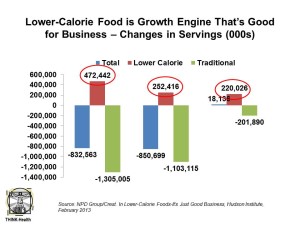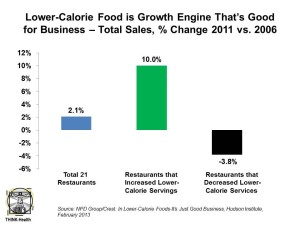 The restaurant chain business employs 10% of U.S. workers and accounts for $660 bn worth of the national economy.
The restaurant chain business employs 10% of U.S. workers and accounts for $660 bn worth of the national economy.
Where restaurant chains are growing fastest is in serving up lower-calorie meals, and it’s been a boon to the bottom-line.
The case for lower calories leading to better business is made in Lower-Calorie Foods: It’s Just Good Business from the Hudson Institute‘s Obesity Solutions Initiative, published February 2013.
In the report, researchers analyzed nitty-gritty restaurant chain data on servings and traffic from 2006-2011 to sort out whether sales of so-called lower-calorie menu items in 21 chains led to improved business. The chains included Applebees, Arby’s, Burger King, Carrabba’s, Chick-fil-A, Chili’s, Cracker Barrel, Denny’s, IHOP, KFC, Longhorn, McDonald’s, Red Lobster, Romano’s Macaroni Grill, Olive Garden, On the Border, Outback, Panera Bread, Sonic, Taco Bell, and Wendy’s.
It turns out that lower-calorie food and beverage items have been a “growth engine” for national restaurant chains, which drive growth in same-store sales, customer traffic, and volume of restaurant services.
Hudson Institute’s Obesity Initiative is the brainchild of Hank Cardello, Senior Fellow, who wrote the seminal book, Stuffed: An Insider’s Look at Who’s (Really) Making America Fat. The Robert Wood Johnson Foundation funded the research.
 Health Populi’s Hot Points: Restaurant chains that served up lower-calorie foods and beverages saw sharp increases in total chain sales. The Hudson Institute concludes that, “restaurant chains now have incentive to lower their calorie footprints to enhance their performance and to help address high obesity rates.”
Health Populi’s Hot Points: Restaurant chains that served up lower-calorie foods and beverages saw sharp increases in total chain sales. The Hudson Institute concludes that, “restaurant chains now have incentive to lower their calorie footprints to enhance their performance and to help address high obesity rates.”
This is a headline-worthy quantitative finding that all stakeholders in health should heed – public policy, business, employers and consumers alike. For public policy, this research can bolster U.S. legislators’ rationale to support healthy food initiatives and continue to move away from subsidizing foodstuffs that make America fat. This is heavy lifting [pun intended]: researchers reporting in The Lancet this week accuse food and drinks companies of using tobacco company-style tactics in undermining public health policy.
For business, company cafeteria outsource companies should continue to morph menus toward more health-ful choices. Consumers have spoken in the marketplace, voting with their feet, spending more on lower-calorie meals than french fries and sugary shakes, based on the NPD consumer data.
Underneath these data, though, is an interesting statistic on “french fry trends:” these went from 24.8% to 24.,1% in terms of fries as a percent share of total foods between 2006 and 2011, and a drop of 1.9% in change of servings versus increase of 1.2% of total food serving growth in the period. Still, fries are more than 20% of chain servings, according to NPD Group/Crest, so this represents a small move at the margin.
Still more consumers are indeed choosing more lower-calorie items from menus, from under 500 calorie “center of the plate” items to desserts under 150 calories, offered at their favorite chains. In addition, the growing food truck movement is making locavore and healthy food options available at workplaces in towns and suburbs. Interestingly, chains are taking a page out of food trucks’ menus, starting to incorporate interesting ethnic and fresh flavors on menus, according to the Hartman Group.
Some of the fastest-growing chains are those offering fresher, healthier, and more local foods such as Sweet Greens and Chipotle — the latter of which is no longer partly owned by McDonald’s, which fully divested its shares in 2006.
 Lower calories are not only good for business, of course — they’re good for health. As a mentor at Blueprint Health, I met with the developers of the HealthyOut app this week and came to learn about their tool to help people find healthy alternatives using a GPS-based technology that marries the menus of top restaurant chains and helps you identify healthy food options that are close-at-hand — sometimes deliverable to where you are, depending on your location and choice.
Lower calories are not only good for business, of course — they’re good for health. As a mentor at Blueprint Health, I met with the developers of the HealthyOut app this week and came to learn about their tool to help people find healthy alternatives using a GPS-based technology that marries the menus of top restaurant chains and helps you identify healthy food options that are close-at-hand — sometimes deliverable to where you are, depending on your location and choice.
The easier it is to access healthy foods, the better for you, HealthyOut knows. An app like this will foster the kind of lower-calorie substitution that the Hudson Institute has uncovered.




 Interviewed live on BNN Bloomberg (Canada) on the market for GLP-1 drugs for weight loss and their impact on both the health care system and consumer goods and services -- notably, food, nutrition, retail health, gyms, and other sectors.
Interviewed live on BNN Bloomberg (Canada) on the market for GLP-1 drugs for weight loss and their impact on both the health care system and consumer goods and services -- notably, food, nutrition, retail health, gyms, and other sectors. Thank you, Feedspot, for
Thank you, Feedspot, for  As you may know, I have been splitting work- and living-time between the U.S. and the E.U., most recently living in and working from Brussels. In the month of September 2024, I'll be splitting time between London and other parts of the U.K., and Italy where I'll be working with clients on consumer health, self-care and home care focused on food-as-medicine, digital health, business and scenario planning for the future...
As you may know, I have been splitting work- and living-time between the U.S. and the E.U., most recently living in and working from Brussels. In the month of September 2024, I'll be splitting time between London and other parts of the U.K., and Italy where I'll be working with clients on consumer health, self-care and home care focused on food-as-medicine, digital health, business and scenario planning for the future...